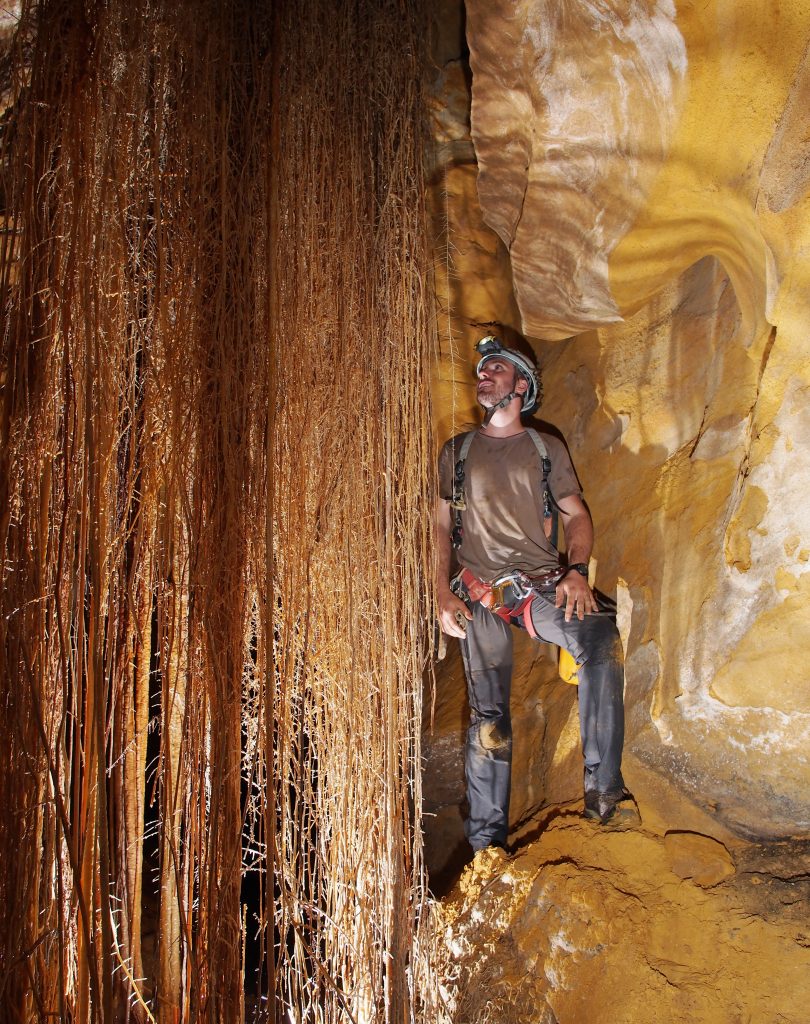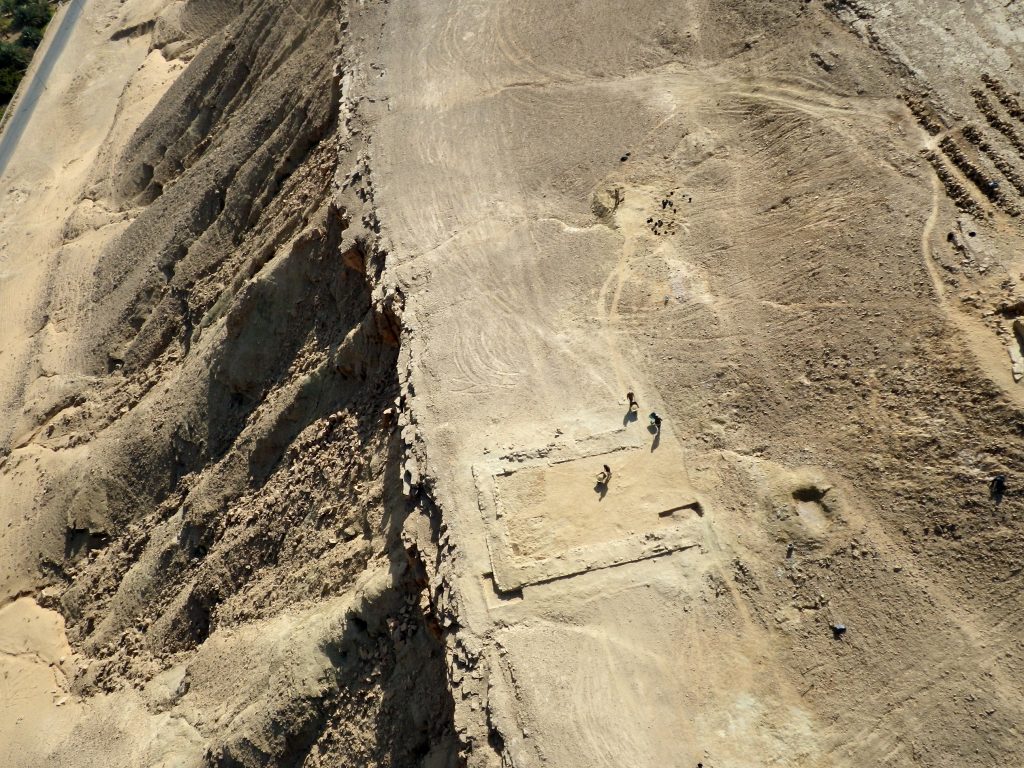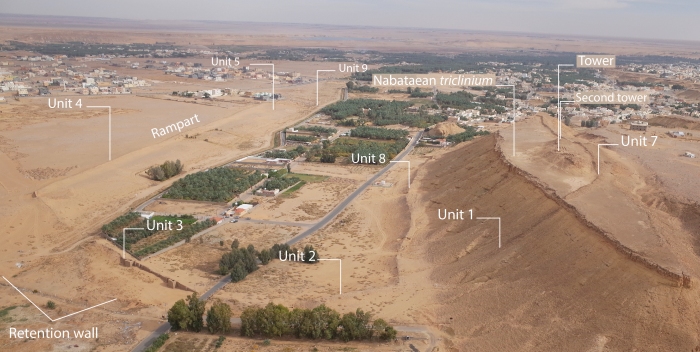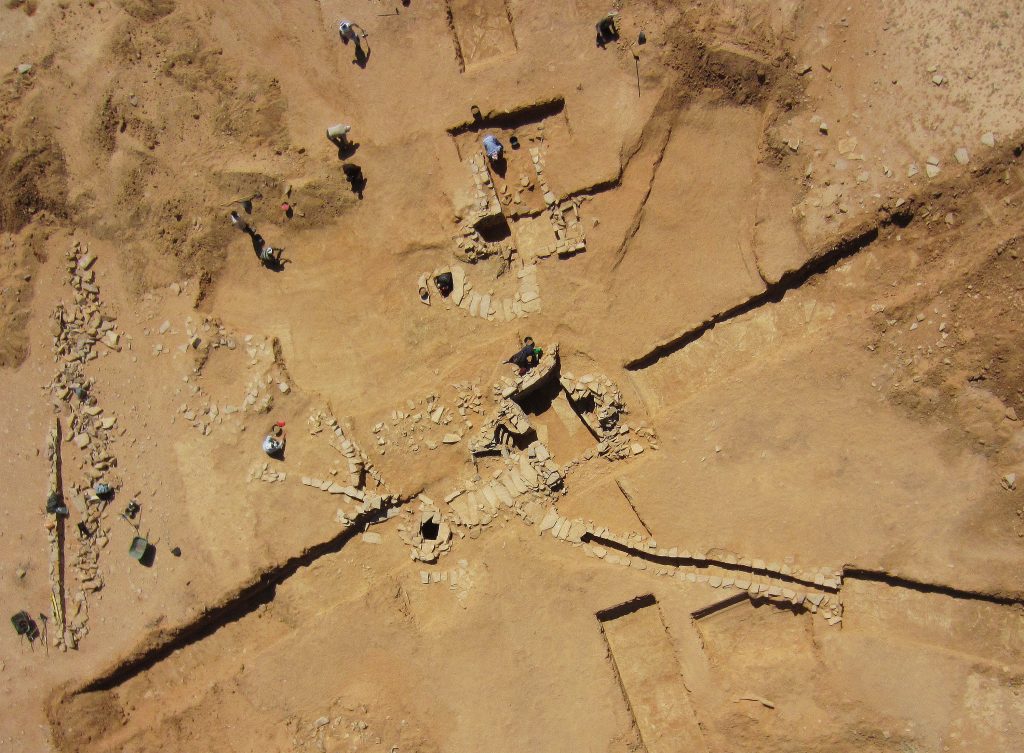Dûmat al-Jandal, l’antique Adummatu/Dumat (Arabie saoudite)
Dûmat al-Jandal se situe à l’extrême fin du Wadi Sirhan, isolée dans un environnement désertique. Entourée de collines calcaires peu élevées, l’oasis forme une vaste dépression d’environ 8 sur 6 km en forme de V, qui a favorisé la recharge des aquifères.

Un spéléologue se tenant debout dans une qanât à Dûmat al-Jandal. ©MADAJ, O. Testa A speleologist standing in a qanāt. ©MADAJ, O. Testa
Une longue occupation
Un grand nombre de vestiges du Paléolithique ancien sont dispersés dans toute la région, mais c’est la découverte d’une plate-forme de 35 m de long sur le promontoire d’al-Burj, dans le secteur ouest de l’oasis, qui atteste de la première présence humaine dans l’oasis au VIe millénaire avant J.-C. La datation au radiocarbone des ossements recueillis dans les tombes avoisinantes a permis d’établir une présence humaine récurrente, entre la seconde moitié du VIe millénaire et le Ier millénaire avant l’ère chrétienne.
L’ancienne Adummatu, carrefour commercial
Le nom arabe de l’oasis dérive de « Adummatu », un toponyme que l’on trouve dans les annales néo-assyriennes du VIIe siècle av. J.-C., et qui désigne également l’un des centres de la confédération tribale de Qédar. Des découvertes récentes confortent cette identification et le rôle de l’oasis en tant que carrefour commercial majeur entre l’Arabie du Sud et la Mésopotamie à l’Âge du Fer.
La période assyrienne et néo-assyrienne
Les fouilles ont ainsi révélé quelques traces matérielles de traditions assyriennes et post-assyriennes. Les datations au carbone 14 témoignent notamment de la réparation d’un petit tannur (four à pain) à plusieurs reprises entre le VIIIe-VIe siècle av. J.-C. et le Ier-IIe siècle. La construction d’un rempart de pierres et de briques crues dans le secteur ouest de l’oasis est le signe d’une présence durable plus récente au cours des IVe-IIe siècles av. J.-C. Ce rempart est partiellement conservé aujourd’hui (2,6 km de long, près de 5 m de haut, et 3 m d’épaisseur par endroits). Il entourait probablement la totalité de l’oasis dans le passé.
La période nabatéenne
La présence de Nabatéens dans la région semble confirmée dès le milieu du Ier siècle av. J.-C. Une inscription, aujourd’hui égarée, indiquait que l’oasis appelée Dûmat, abritait un sanctuaire de Dushara et un fort commandé par un stratopédarque sous Malichos II, en l’an 45 de notre ère. Ce fort préfigurait le Qasr Marid, impressionnante forteresse dominant l’oasis aujourd’hui. La nécropole composée de tombes collectives monumentales s’est développée plus à l’ouest, dans le quartier al-Sunamiyat. Dans la zone occidentale, fermes domestiques ou habitations parsemaient un paysage oasien bucolique de parcelles cultivées et de ruelles étroites, surplombées par un triclinium à ciel ouvert datant du Ier-IIe siècle.

Vue du triclinium nabatéen au sommet du promontoire Rijm al-Burj. © MADAJ, G. Charloux View of the Nabataean triclinium at the top of the Rijm al-Burj promontory. © MADAJ, G. Charloux
L’intégration à la province romaine d’Arabie
Comme la plupart des places nabatéennes, Dûmat a été intégrée à la province romaine d’Arabie, vraisemblablement dès 106, comme le prouve la découverte récente de graffiti incisés par les membres d’unités de cavalerie et de cohortes d’infanterie romaine composées d’auxiliaires d’origine nabatéenne. Un texte arabe préislamique provenant du Wadi az-Zilliyyat, situé à quelques kilomètres de l’oasis, atteste une présence chrétienne continue dans la région en 548/549 de l’ère chrétienne.

L’ancien rempart du secteur ouest de Dumat al-Jandal, en regardant vers l’est. © Thomas Sagory www.du-ciel.com; adapted by Guillaume Charloux The ancient rampart in the western sector at Dumat al-Jandal, looking east. © Thomas Sagory www.du-ciel.com; adapted by G. Charloux
Dûmat à la période islamique
Dûmat est célèbre pour avoir été la cible de trois raids du Prophète et de ses compagnons en 626, 628 et 630, en particulier contre Ukaydir, souverain probablement chrétien. Après le début de la période islamique, l’oasis semble avoir progressivement perdu son statut de carrefour caravanier. Cependant, un grand nombre d’inscriptions arabes datant des premiers siècles de l’Hégire a récemment été répertorié dans la région et confirme son dynamisme économique au début de l’époque islamique. La mosquée du calife ʿUmar ibn al-Khattab, avec son minaret à étages, constitue d’ailleurs un lieu touristique régional majeur.
Aux XIXe et XXe siècles, l’oasis comptait plus de douze villages dispersés, parfois appelés « Suq ». Ces villages ont été le théâtre de conflits tribaux sanglants, jusqu’à la prise de pouvoir du troisième État saoudien en 1921.
Le programme de recherche
Étudié depuis 1962, le site a fait l’objet d’investigations par le Saudi Comprehensive Survey dans les années 1980, puis, entre 2009 et 2018, par un projet archéologique conjoint saoudien, français et italien (Guillaume Charloux, CNRS et Romolo Loreto, Université L’Orientale, Naples). L’équipe italienne poursuit ses travaux sur place.

Une installation hydraulique découverte dans le désert, en marge de l’oasis de Dumat al-Jandal, en cours de fouille. © MADAJ, R. Schwerdtner A hydraulic installation discovered in the desert, on the edge of the oasis of Dumat al-Jandal, during the excavation. © MADAJ, R. Schwerdtner
English version
Dumat al-Jandal lies at the southern extremity of the Wadi Sirhan, in a remote desert environment. Encircled by low limestone hills, the oasis is a large V-shaped depression (ca. 8 x 6 km), which favoured the recharge of aquifers.
The earliest remains
Although a large number of earlier Palaeolithic remains are scattered throughout the region, the discovery of a 35-m-long platform on the al-Burj promontory in the western sector of the oasis provides evidence for the first human presence in the oasis in the 6th mill. bce. Radiocarbon dating of collected bones in tombs yielded a sequence of recurrent human presence in Dumat, ranging from the second half of the 6th millennium until the 1st millennium bce.
Assyrian and Neo-assyrian Adummatu
The Arabic name of the oasis derives from “Adummatu”, a toponym found in the Neo-Assyrian annals in the 7th cent. bce, which was also one of the centres of the tribal confederation of Qedar. Recent findings strengthen this identification and the role of the oasis as a major trade crossroads between South Arabia and North Mesopotamia in the Iron Age. Excavations revealed abundant material culture traces attributable to Assyrian and post-Assyrian traditions, while an oven was successively repaired from the 8th-6th century bce until the 1st–2nd century ce according to 14C datings. A durable presence in the oasis during the 4th-2nd cent. bce is also visible through the construction of a stone and mud-brick rampart in the western sector of the oasis. This rampart is preserved today up to 2.6 km in length, nearly 5 m high, and 3 m thick in places. It probably entirely enclosed the oasis in the past.
The nabatean city
Nabataean presence seems likely in the region from as early as the mid-1st cent. bce. An inscription, today lost, documents that the oasis housed a sanctuary of Dushara and a fort commanded by a stratopedarch under Malichos II in 45 ce. This fort would appear to have been a predecessor of the Qasr Marid, an impressive fortress dominating the oasis today. The necropolis composed of monumental collective tombs developed further west, in the al-Sunamiyat quarter. In the western area, domestic farms or dwelings were sparsely distributed in a bucolic oasis landscape of cultivated plots with narrow streets, overlooked by a 1st–2nd century ce open-air triclinium.
Like most of Nabataea, Dumat was integrated into the Roman Province of Arabia, conceivably as early as 106 ce, as proved by the recent discovery of inscriptions from Auxiliary cavalry units and infantry cohorts. Later a pre-Islamic Arabic text from nearby Wadi az-Zilliyyaṭ attests to a continued Christian presence in the area in 548/549 ce.
The islamic period
Dumat is famous for being the target of three raids by the Prophet and his companions in 626, 628 and 630, in particular against Ukaydir. After the early Islamic period, the oasis seems to have gradually lost its status as an important crossroads. However, a large number of Arabic inscriptions from the first centuries of the Hijra have recently been recorded in the region. A mosque said to have been built by caliph ʿUmar ibn al-Khaṭṭab is still very famous.
In the 19th and 20th centuries, the oasis consisted of more than twelve scattered villages, sometimes known as ‘Suq’. These villages were the stage of bloody tribal conflicts, until the takeover of the third Saudi State in 1921.
Research program
The oasis was investigated since 1962, but mostly by the Saudi Comprehensive Survey in the 1980s. Between 2009 and 2018, it has been the focus of a joint Saudi-Italian-French archaeological project (Guillaume Charloux (CNRS) and Romolo Loreto (University L’Orientale, Naples)). The Italian colleagues continue their work in the field today.
Articles
Ouvrages
- Charloux G. & Loreto R., en préparation, Dûma 6. The 2016 Report of the Saudi–Italian–French Archaeological Project at Dûmat al-Jandal, Saudi Arabia. Series of Archaeological Refereed Studies. Saudi Heritage Commission, Ministry of Culture, Riyadh
- Charloux G. & Loreto R., sous presse, Dûma 5. The 2014-2015 Report of the Saudi–Italian–French Archaeological Project at Dûmat al-Jandal, Saudi Arabia. Series of Archaeological Refereed Studies. Saudi Heritage Commission, Ministry of Culture, Riyadh
- Charloux G. & Loreto R., 2021, Dûma 4. The 2013 Report of the Saudi–Italian–French Archaeological Project at Dûmat al-Jandal, Saudi Arabia. Series of Archaeological Refereed Studies 46. Saudi Commission for Tourism and National Heritage, Riyadh. https://hal.archives-ouvertes.fr/hal-02492991
- Charloux G. & Loreto R. (éds.), 2021, Dûma 3. The 2012 Report of the Saudi–Italian–French Archaeological Project at Dûmat al-Jandal, Saudi Arabia. Series of Archaeological Refereed Studies 45. Saudi Commission for Tourism and National Heritage, Riyadh. https://hal.archives-ouvertes.fr/hal-02492932
- Charloux G. & Loreto R. (éds.), 2016, Dûma 2. The 2011 Report of the Saudi–Italian–French Archaeological Project at Dûmat al-Jandal, Saudi Arabia. Series of Archaeological Refereed Studies n°41. Saudi Commission for Tourism and National Heritage, Riyadh, https://hal.archives-ouvertes.fr/hal-01509443/
- Charloux Guillaume & Loreto R., 2013, Dûmat al-Jandal. 2,800 years of History in Saudi Arabia. Ouvrage bilingue anglais-arabe, EADS. http://hal.archives-ouvertes.fr/hal-00997895
- Charloux Guillaume & Loreto R., with the participation of al-Tirâd ʿA.H., al-Qa`îd ʿA.A., al-Dâyil ʿA.I., al-ʿArjân H.M., al-Murshd ʿA.N., al-Mâlikî Th.ʿA, Marcolongo A., Morel Q., al-Qahtânî D.M., al-Qahtânî M.H., Schiettecatte J. & Siméon P., 2014. Dûma I. Report of the Saudi-Italian-French Archaeological Project at Dûmat al-Jandal (Saudi Arabia). Saudi Commission for Tourism and Antiquities. http://hal.archives-ouvertes.fr/hal-00997906
Articles
- Charloux G., AlMalki T. & AlQaeed A., 2021. « The “walled oases” phenomenon. A study of the ramparts in Dūmat al-Jandal and other pre-Islamic sites in north-western Arabia », Arabian Archaeology and Epigraphy. https://doi.org/10.1111/aae.12177
- Munoz O., Cotty M., Charloux G., Bouchaud C., Monchot H., Marquaire C., Zazzo A., Crassard R., Brunet O., Boschloos V. & al-Malki T., 2020 « Marking the sacral landscape of a north Arabian oasis: a sixth-millennium BC monumental stone platform and surrounding burials », Antiquity 375 (June), https://doi.org/10.15184/aqy.2020.81
- Loreto, R. 2019. “The ancient Adummatu, a caravan port of trade on the limes arabicus”. In A. Levin (ed) The Roman City in Antiquity, Yale University –Università della Basilicata.
- Loreto, R. 2019. “The Assyrians in Arabia. The archaeological evidence”. In J.-F. Breton (ed) La guerre en Arabie, Atti della XXIIeme Réncontre Sabéenne, Paris 6-9 June 2017, Geuthner-CEFAS.
- Loreto, R. 2019. “The Role of Dûmat al-Jandal in Ancient North Arabian Routes from Pre-History to Historical Periods”, in M. Luciani (ed), OREA 4, The Archaeology of North Arabia, Austrian Academy of Science, 299-316.
- Charloux G., 2018, « Rythmes et modalités du peuplement d’une oasis du nord-ouest de l’Arabie. Sept campagnes (2010-2017) sur le site de Dûmat al-Jandal », CRAIBL 2018 (I), p. 11-46.
- Charloux G., Loreto R., et al. 2018, « Dûmat al-Jandal _ 2010-2011 Seasons », Atlal 25, 2018, p. 107-124 (anglais et traduction arabe).
- Loreto, R. 2018. “Results from the 2009–2016 excavation seasons in the historical centre of D?mat al-Jandal, ancient Adummatu”, in Proceedings of the Seminar for Arabian Studies 48: 151-164.
- Marquaire C., Charloux G., Cotty M., Malki T., Mensan R., Qahtani D., Schwerdtner R., 2018, « Technology Transfer or Local Invention? A Water Collecting system of the Desert in Northern Arabia », Colantib XXXVIII, p. 251-268.
https://www.academia.edu/37604905/Technology_transfer_or_local_invention_A_water_collecting_system_in_the_northern_arabian_desert - Charloux G., P. Courbon, M. Thomas, O. Testa, 2017, « Mapping an ancient qanat system in a northern Arabian urbanized oasis. Results of GIS analysis and archaeological survey », Water History 10: 31-51, DOI 10.1007/s12685-017-0203-4, http://rdcu.be/tM26
- Charloux G., Bouchaud C, Durand C & Monchot R., 2016, « Banqueting in a Northern Arabian Oasis: A Nabataean Triclinium at Dûmat al-Jandal, Saudi Arabia ». BASOR 375, p. 13-34.
- Hilbert Y.H., Crassard R., Charloux Guillaume & Loreto R., 2015, « Nubian technology in northern Arabia: Impact on interregional variability of Middle Paleolithic industries », Quaternary International 2015, p. 1-17.
- Charloux G., Cotty M. & Thomas A., 2014, « Nabataean or Not? The Ancient Necropolis of Dumat. First Stage: A Reassessment of Al-Dayel’s Excavations », Arabian Archaeology and Epigraphy 25, p. 186‑213. http://dx.doi.org/10.1111/aae.12044.
- Charloux G. & Loreto R., 2013, « Oasis rediscovered. Dûmat al-Jandal », Saudi Voyager (Winter 2013), p. 16-18.
- Loreto R. & Charloux G., 2013, « The Saudi-Italian-French Archaeological Project at Dûmat al-Jandal (Preliminary Report of the 2012 Season) », La Newsletter di Archeologia CISA 4, p. 211–251. http://www.unior.it/ateneo/8917/1/volume-4-anno-2013.html
- Loreto R., Charloux G. & Makinson M., 2013, « Dûmat al-Jandal, oasis de l’Arabie déserte », Qantara 87, p. 12-15.
- Charloux G., 2012, « Known and Unknown Archaeological Monuments in Dûmat al-Jandal », Proceedings of the Seminar for Arabian Studies 42, p. 41-56.
- Charloux G. & Loreto R., 2013, « The Saudi-Italian-French archaeological project at Dumat al-Jandal: an historical and archaeological overview ». In A.Sedov (ed) Rencontres Sabéennes XV, Mosca, State Museum of Oriental Art – Institute of Oriental Studies, Russian Academy of Science, p. 131-154.
- Charloux G., Loreto R., al-Tirâd ʿA.H., al-Qa`îd ʿA.A., al-Dâyil ʿA.I., al-ʿArjân H.M., al-Murshd ʿA.N., al-Mâlikî Th.ʿA, Marcolongo A., Morel Q., al-Qahtânî D.M., al-Qahtânî M.H., Schiettecatte J. & Siméon P., 2012, « Dûmat al-Jandal. Immémoriale oasis d’Arabie Saoudite », Archéologia 495 (janvier), p. 46-55.
- Charloux G. et Loreto R., 2011, « Dûmat al-Jandal (Arabie saoudite), premières explorations de l’oasis par la Mission archéologique italo-franco-saoudienne~», CRAIBL 2011, p. 909-919.
- Loreto R. & Charloux G., 2011, « Deserto Verde », Archeo, Attualità del Passato 321 (novembre), p. 26-37.
- Monchot H., « Camels in Saudi oasis during the last two millennia; the examples of Dûmat al-Jandal (Al-Jawf Province) and al-Yamâma (Riyadh Province) », Anthropozoologica 49(2), p.195-206. 2014
doi: http://dx.doi.org/10.5252/az2014n2a03 - Thomas M. Testa O. & Courbon P., 2013, « Les puits et qanâts de Dûmat al-Jandal (arabie saoudite) ». Spelunca 129, p. 43–47.
- Charloux G., sous presse (accepté 2017), « Rhythms and patterns of settlement in an oasis in northwestern Arabia. Main results of the French contingent of the Saudi-Italian-French Archaeological Project in Dûmat al-Jandal (2010-2017) », 1st Saudi Archaeology Convention 2017.




